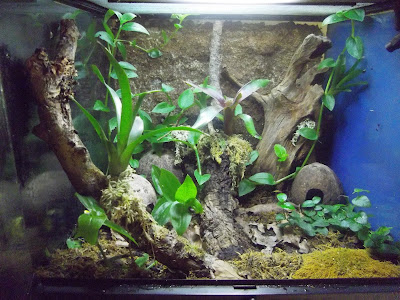Anyway as most of you know I have been battling with tadpoles developing SLS for a long time. SLS is a malformation while metamorphosis occurs. Frogs that develop seemingly normally and have fully formed hind legs and a well formed body can eventually morph with very thin malformed front legs or no fronts legs at all.
There are no definite theories on what can cause SLS and no concrete cure. People I have spoken to about the issue have said that amongst other things SLS can occur when:
- Tadpoles or parent frogs are not exposed to sufficient UVB light
- The tadpoles are raised in water of an inappropriate temperature
- Genetic defects caused by bad parent blood lines or by inbreeding
- The water being used is of the wrong pH value
- The tadpoles are fed an inappropriate diet
- Supplementation of the parent frog
This is a pair of auratus.
This is a Tinc. Cobalt that was doing very well as a tadpole and the muck in his rearing container impaired the view of his legs and this was the result
Here is another cobalt tadpole that was found to have SLS when his front legs popped
All of the frogs/tadpoles were euthanised by a trained Vet in the kindest possible way.
In the past I used boiled, cooled tap water to raise my tadpoles and found that depending on species tadpoles would either die very early on from a mouth fungus or would develop nicely until the point of front legs. After much experimentation and talks with other breeders I started trying different types of water. Bottled water was working well I didn't loose any tadpoles to mouth fungus but lost many to SLS. Then someone suggested rain water collected locally. Well since using rainwater collected in a tank outside my back door I am pleased to report that things are getting much better I have only lost dubious looking probably infertile eggs. The numbers produced are a little lower but again I am always changing how things are done. The parent frogs now get a good varied diet and I dust every feeding with Repashy ICB calcium supplement. The tadpoles are kept at room temperature in plastic pots with nothing but rain water and a dry oak leaf for cover. They are fed a mixture of fish food, spirulina flake and dried bloodworm every other day. All of this has finally paid off if you remember with the very first D. Leucomelas that we had morph without SLS (he's still doing great by the way), and now I'm pleased as punch to show you the following pictures, these are the two D. Tinc. Powder Blue tadpoles we have that have come furthest along thus far and should hopefully be taking their first steps onto dry land soon:
I'll update you later when they are out and about =)






















































